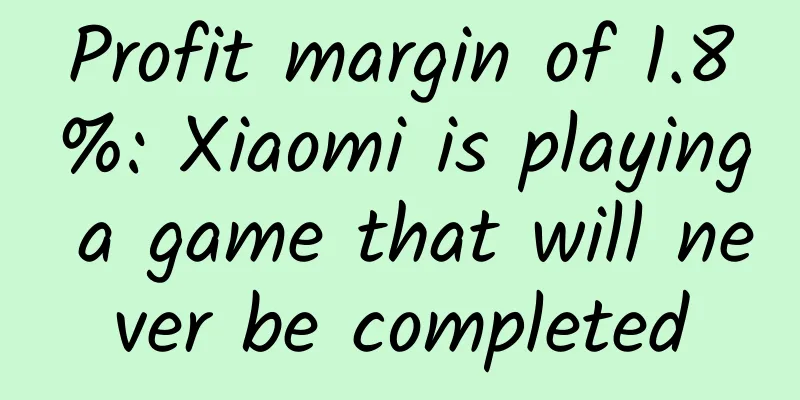Profit margin of 1.8%: Xiaomi is playing a game that will never be completed

|
Recently, through the announcement of Xiaomi's investment in Midea, the industry learned about Xiaomi's main performance in the past year. Among them, the revenue in 2013 was about 26.583 billion yuan, and the net profit was about 347 million yuan. This is also the first time that Xiaomi has disclosed its financial data to the public. However, the financial data of Xiaomi disclosed by the Wall Street Journal in November this year is far from that. In other words, from the perspective of profit, the profit disclosed by Xiaomi itself is only 1/10 of that reported by the Wall Street Journal. Here we cannot be sure which statistical data is the true reflection of Xiaomi's performance. Since it is the official data released by Xiaomi, we still take it as the standard, and simply combine it with the changes that have occurred at the main nodes in the development process of Xiaomi to see what Xiaomi is thinking or what kind of chess game it is playing? As we all know, the object or business model that Xiaomi wanted to emulate at the beginning should be Apple, which can be seen from the fact that Xiaomi CEO Lei Jun is described as the Chinese Steve Jobs (also known as Lei Jun). In addition, from the original slogan of Xiaomi mobile phones "Born for fever" and product pricing, it is also hoped not to pursue sales, but to care more about profits. Of course, the difference from Apple is that Apple mainly relies on brand premium, innovation and high quality to obtain absolute high profits, while Xiaomi relies more on economical and efficient Internet marketing (including fan marketing and e-commerce marketing with unique Chinese characteristics) to dilute costs and achieve relatively high profits. Don't get me wrong, we are not saying that the quality of Xiaomi mobile phones is not good here, but from the perspective of imitating Apple's business model, although both parties are mainly pursuing a high-profit business model, the means or support points of realization are completely different: Xiaomi finally chose to dilute costs through marketing to obtain relatively high profits, which is easier to copy than Apple's model of obtaining absolute high profits through brand premium, innovation and high quality, especially in the Chinese market, which has always lacked innovation (including marketing methods) and is good at imitation. As for this point, the smart Lei Jun had foresight or had considered it. Lei Jun's foresight was confirmed by the imitation of many Chinese mobile phone manufacturers later, especially Huawei, which was the first to imitate Xiaomi. It should be the manufacturer and brand that imitated Xiaomi with the best effect, without a doubt. But Xiaomi felt considerable pressure just because of this company. At the same time, with the increasing maturity of the smartphone industry itself and the inclination of growth momentum to the low-end market, Xiaomi's model of imitating Apple by diluting costs through marketing to obtain relatively high profits is bound to encounter severe challenges (industry development trends and competition within the industry), and may even disappear in the future. By then, Xiaomi will have no characteristics of its own except for the brutal price war with other Chinese mobile phone manufacturers. Xiaomi will become a mediocre and unselling enterprise in the eyes of the industry and future capital markets, just like other mobile phone manufacturers. The launch of Redmi phones for the low-end market and their sales surpassing Xiaomi phones are considered turning points. We call them turning points because they mark the end of Xiaomi's path to emulating the Apple model. However, it should be noted that this end is due to both external factors of market competition and Lei Jun's active pursuit of change. After all, as we mentioned earlier, Lei Jun had already predicted the subsequent situation (it should be when Huawei's independent brand Honor became popular). The industry may have noticed that before and after Xiaomi released the Redmi phone, what impressed us about Xiaomi? It is no longer Xiaomi mobile phones, but it is involved in a large number of so-called smart hardware and has begun to cross borders, such as smart routers, Xiaomi TVs, Xiaomi boxes, mobile power banks, etc. The industry calls this the expansion of the Xiaomi ecosystem, and these products are almost all based on cost-effectiveness. The industry is very clear that the ultimate pursuit of products that focus on cost-effectiveness is sales and revenue. In fact, at this time, when domestic mobile phone manufacturers are still focusing on the mobile phone itself, and even talking about feelings, Lei Jun has already focused Xiaomi on expanding its business and revenue scale. At the same time, the industry's rumor that Xiaomi is China's Apple has changed to a model where Xiaomi is somewhere between Apple and Amazon (as Lei Jun said). This trend has even more than lasted this year. In addition to continuing to release and improve smart hardware and cross-border products (such as the smart bracelet and air purifier newly launched this year), expansionary investment has become the main theme of Xiaomi. For example, it invested in Youku Tudou and iQiyi to enter the video business; it invested in Midea to enter the smart home appliance market; and it invested in 21Vianet to enter the cloud service market. The reports on these investments and expansions even exceeded the attention paid to Xiaomi. In addition, the market effect of Xiaomi's previous cost-effective strategy finally made it enter the top three in the global smartphone market this year (in terms of shipments), which undoubtedly provided good support for the industry's investment and expansion of Xiaomi. I wonder if the industry has noticed that Xiaomi and Amazon have become quite similar and comparable. First, both companies use revenue expansion as their main business model (profit is no longer important, Amazon has almost zero profit, and Xiaomi's profit margin is also extremely low, only 1.8%); second, both companies invest in multiple fields based on the so-called relevance to their main business (such as Amazon's e-commerce membership and Xiaomi's ecosystem), especially when they are close to profitability, they invest immediately; third, it is impossible or difficult to prove whether these newly invested fields (such as Amazon's Kindle hardware, video games, cloud computing, drones and Xiaomi's series of smart hardware, cloud services, video content) can promote the development of the main business; fourth, it is unknown whether these newly invested fields can make a profit, but failure to lose all the money is normal (Amazon CEO Bezos said before); fifth, some investors still recognize this model and even praise it as an innovator in the industry; finally and most importantly, it is unknown when Amazon's zero-profit model will make money, and it may never make money, at best it will be a small profit. We seem to have no way or no qualifications to question whether Amazon's business model is worth learning from or has any innovation. We even suspect that the model advocated by Bezos contains a certain degree of deception. But one thing is certain, it is much easier to imitate the Amazon model than the Apple model. Because it cleverly avoids the biggest business challenge of every enterprise, which is to maximize profitability (profit and profit margin) by constantly investing in exchange for scale (not knowing that input and output are proportional). Lei Jun seems to have realized from Amazon that this model is beneficial to himself. While using investment to cover up its declining competition and profitability in the smartphone market, it has also created a Chinese Amazon for investors. In other words, it indirectly tells investors not to measure Xiaomi by profit, let alone determine Xiaomi's future. Xiaomi's future lies in more future-based investments. As for when these future-based investments will bring about an increase in profits and profit margins, it will still be in the future. So how far is the future? In the future. While the industry is still arguing that the Xiaomi model has failed and being complacent about its low profit margins, Xiaomi has already found a model that its competitors can never defeat, namely the Amazon model. In this sense, Xiaomi is eager to say that its profit margins are low, thinking that it is more like the Amazon model to find a more convincing reason for the industry and investors. If the development of this model is compared to a game of chess, the game that Xiaomi, led by Lei Jun, is playing now will be a game that will never be completed and has no opponents. Of course, the premise is that the model of Amazon on the other side of the ocean is still recognized by investors. However, Lei Jun needs to be reminded that this year, investors seem to have doubts about the Amazon model, and the stock price has fallen by more than 30% cumulatively, but Bezos still stubbornly believes that there is no problem with its model and will stick to it until retirement. From this point of view, if Lei Jun said before that Xiaomi's success mainly depends on luck, then at least Xiaomi's luck will remain for some time in the future, but then again, everyone knows that no matter how good your luck is, it will run out, right? As a winner of Toutiao's Qingyun Plan and Baijiahao's Bai+ Plan, the 2019 Baidu Digital Author of the Year, the Baijiahao's Most Popular Author in the Technology Field, the 2019 Sogou Technology and Culture Author, and the 2021 Baijiahao Quarterly Influential Creator, he has won many awards, including the 2013 Sohu Best Industry Media Person, the 2015 China New Media Entrepreneurship Competition Beijing Third Place, the 2015 Guangmang Experience Award, the 2015 China New Media Entrepreneurship Competition Finals Third Place, and the 2018 Baidu Dynamic Annual Powerful Celebrity. |
>>: 360 brings in the Coolpad master: How much of a role can he play?
Recommend
Ant Financial is Alibaba's main weapon against Tencent
I have always believed that the outside world has...
Understand at a glance: Children aged 3-11 are starting to receive the new coronavirus vaccine, all the questions you care about are here!
In accordance with the overall national deploymen...
The underlying logic of Douyin’s product selection
There is a popular saying in the Douyin e-commerc...
Build a user growth system from scratch?
The user growth system is an operational means fo...
Can light travel through "time cracks" and interfere with the past and future? Scientists prove it for the first time
Science Fiction Network, April 13th. Scientists h...
The third round of 51CTO developer community administrator recruitment has been successfully completed
[51CTO.com original article] Thank you very much ...
With so many H5s at the end of the year, why do Alipay and NetEase Cloud Music dominate your circle of friends?
At the end of the year and the beginning of the n...
Community Operation | Master these 3 steps to make your community "live"
People always think that their own communities ar...
520 marketing strategy! Here it comes
Although 520 is an ordinary holiday, its pronuncia...
Love of mathematics: the extraordinary genius Galois and his beautiful theory
The mathematical genius Galois died in a duel at ...
An analysis of the entire process of Keep’s customer acquisition: How to gain 140 million users in 3 years
In October 2017, Keep surpassed Yuedongquan Runni...
Community Operation Guide: How to double the activity?
Community is as important as socializing . People...
Quantum of the Tomorrow: The most awesome photo ever
In the Southern Song Dynasty, during the Battle o...
Keep China's rice bowl secure! Chinese scientists have made important discoveries
"High yield " and " early maturity...
How to design a landing page to reduce information flow costs by 60%?
With the promotion competition so fierce today, s...









